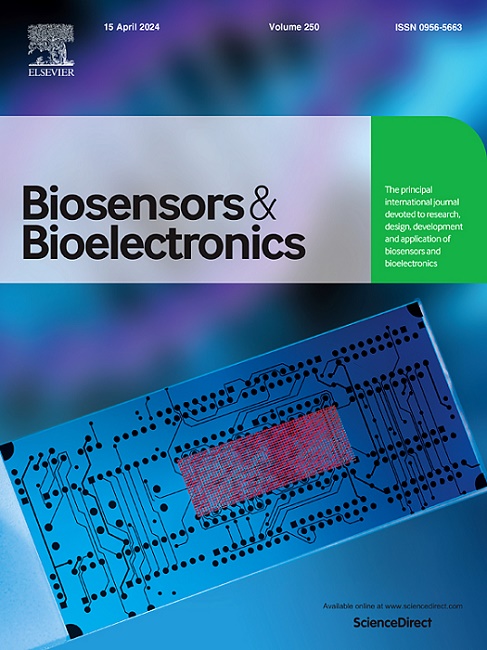Tumor microenvironment-responsive dynamic self-assembly of DNAzyme nanowires for high-contrast imaging of multiple messenger RNAs and chemotherapy
IF 10.7
1区 生物学
Q1 BIOPHYSICS
引用次数: 0
Abstract
Messenger RNAs (mRNAs) are a category of protein-coding RNA, and their dysregulation is closely implicated in diverse cancers. Static DNA nanodevices have been engineered for the imaging and therapy, but they rely on the pre-assembly of DNA components and are limited by the low imaging contrast. Herein, we demonstrate the tumor microenvironment-responsive dynamic self-assembly of DNAzyme nanowires for high-contrast imaging of multiple mRNAs and chemotherapy. We design a cruciform DNA module (C-model) as a basic structural unit of DNAzyme nanowire, which consists of two DNAzyme strands and two substrate strands with the chemotherapeutic drug doxorubicin (DOX) being inserted into the C-models by inlaying between guanine and cytosine. Once approaching tumor cells, C-models with two split i-motif spontaneously assemble into a DNAzyme nanowire through protonation-driven Hoogsteen interaction in response to extracellular acidic microenvironments. Upon the internalization, intracellular TK1 mRNA and GalNAc-T mRNA hybridize with the overhangs of DNAzyme strands and substrate strands to form a stable DNAzyme/substrate/target three-way junction, inducing the cleavage of substrates by DNAzymes and the recovery of Cy5/Texas Red fluorescence. AS1411 aptamer-functionalized DOX-nanowires can selectively endocytose into cancer cells via AS1411-mediated recognition of nucleolin overexpressed on the cancer cell surface. Notably, the dynamic self-assembly of DNAzyme nanowires is characterized by efficient intracellular delivery and intrinsic resistance to nucleases, facilitating the high-contrast imaging of mRNAs. This method can accurately measure TK1 mRNA and GalNAc-T mRNA in living cells and discriminate multiple mRNAs in breast cancer tissues and their normal counterparts, providing a powerful platform for clinical diagnosis.
肿瘤微环境响应动态自组装DNAzyme纳米线用于多信使rna的高对比度成像和化疗
信使RNA (mrna)是一类蛋白质编码RNA,其失调与多种癌症密切相关。静态DNA纳米器件已经被设计用于成像和治疗,但它们依赖于DNA成分的预组装,并且受到低成像对比度的限制。在这里,我们展示了肿瘤微环境响应的DNAzyme纳米线的动态自组装,用于多种mrna和化疗的高对比度成像。我们设计了一个十字形DNA模块(c模型)作为DNAzyme纳米线的基本结构单元,该模块由两条DNAzyme链和两条底物链组成,化疗药物多柔比星(DOX)通过嵌套在鸟嘌呤和胞嘧啶之间插入到c模型中。一旦接近肿瘤细胞,具有两个分裂i基序的c -模型通过质子驱动的Hoogsteen相互作用自发地组装成DNAzyme纳米线,以响应细胞外酸性微环境。内化后,细胞内TK1 mRNA和GalNAc-T mRNA与DNAzyme链和底物链的悬垂部分杂交,形成稳定的DNAzyme/底物/靶标三向连接,诱导DNAzyme切割底物,恢复Cy5/Texas Red荧光。AS1411适配体功能化的dox纳米线可以通过AS1411介导的对癌细胞表面过表达的核蛋白的识别,选择性地内吞到癌细胞中。值得注意的是,DNAzyme纳米线的动态自组装具有高效的细胞内递送和对核酸酶的内在抗性,有利于mrna的高对比度成像。该方法可准确测定活细胞中的TK1 mRNA和GalNAc-T mRNA,区分乳腺癌组织中的多种mRNA及其正常对应物,为临床诊断提供有力平台。
本文章由计算机程序翻译,如有差异,请以英文原文为准。
求助全文
约1分钟内获得全文
求助全文
来源期刊

Biosensors and Bioelectronics
工程技术-电化学
CiteScore
20.80
自引率
7.10%
发文量
1006
审稿时长
29 days
期刊介绍:
Biosensors & Bioelectronics, along with its open access companion journal Biosensors & Bioelectronics: X, is the leading international publication in the field of biosensors and bioelectronics. It covers research, design, development, and application of biosensors, which are analytical devices incorporating biological materials with physicochemical transducers. These devices, including sensors, DNA chips, electronic noses, and lab-on-a-chip, produce digital signals proportional to specific analytes. Examples include immunosensors and enzyme-based biosensors, applied in various fields such as medicine, environmental monitoring, and food industry. The journal also focuses on molecular and supramolecular structures for enhancing device performance.
 求助内容:
求助内容: 应助结果提醒方式:
应助结果提醒方式:


